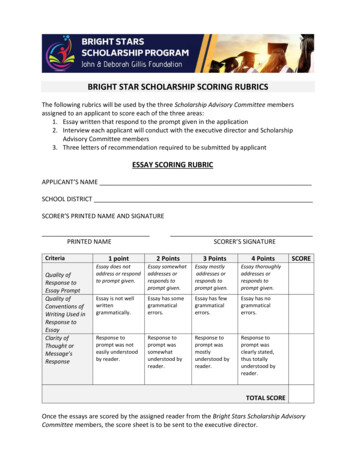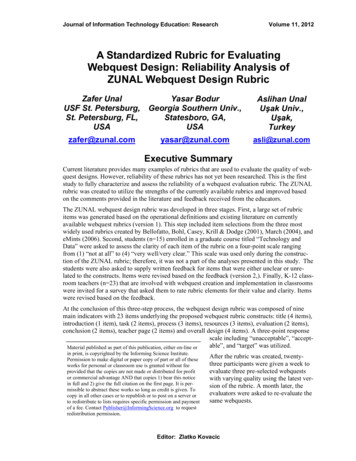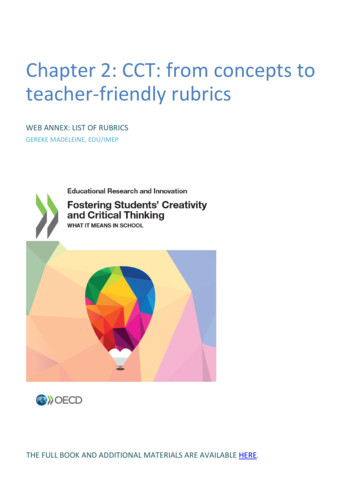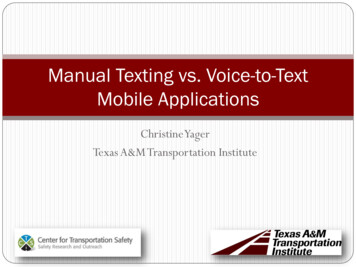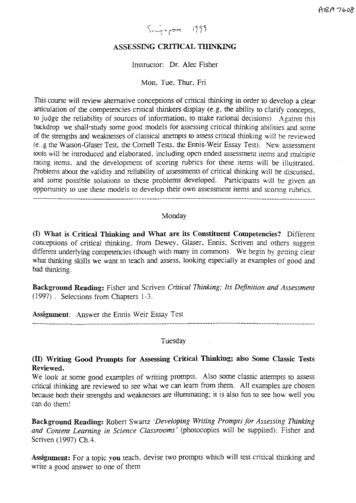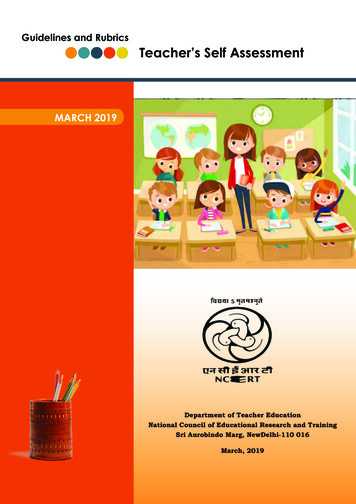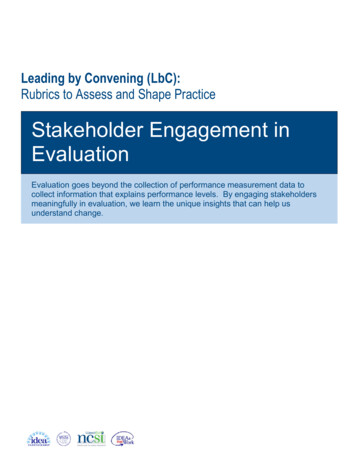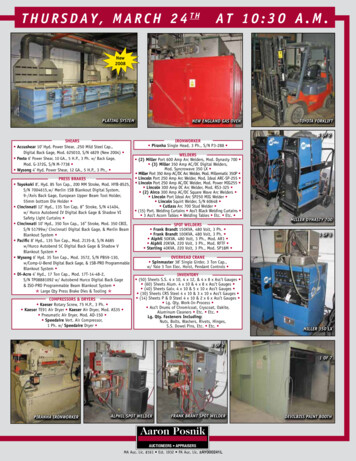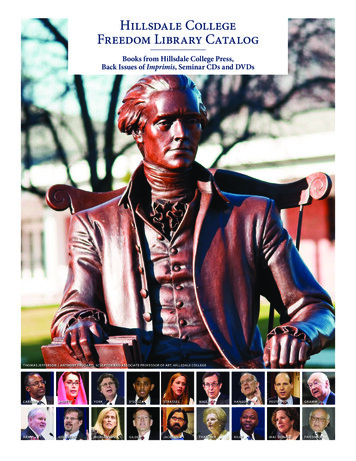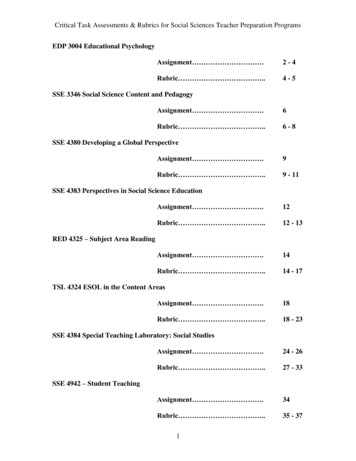
Transcription
Critical Task Assessments & Rubrics for Social Sciences Teacher Preparation ProgramsEDP 3004 Educational PsychologyAssignment .2-4Rubric .4-5SSE 3346 Social Science Content and PedagogyAssignment .6Rubric .6-8SSE 4380 Developing a Global PerspectiveAssignment .9Rubric .9 - 11SSE 4383 Perspectives in Social Science EducationAssignment .12Rubric .12 - 13Assignment .14Rubric .14 - 17RED 4325 – Subject Area ReadingTSL 4324 ESOL in the Content AreasAssignment .18Rubric .18 - 23SSE 4384 Special Teaching Laboratory: Social StudiesAssignment .24 - 26Rubric .27 - 33Assignment .34Rubric .35 - 37SSE 4942 – Student Teaching1
Critical Task Assessments & Rubrics for Social Sciences Teacher Preparation ProgramsEDP 3004: Educational Psychology (3 credits)EDP 3004: E-folio Artifact (25 points).The State of Florida requires that those seeking certification or a professional degree in aCollege of Education demonstrate their ability to understand and apply the FloridaAccomplished Educator Practices (FEAPS) by developing an online portfolio of thecoursework they have completed. Each course in the College thus has an e-folioassignment that satisfies a different set of FEAPs requirements. You must successfullycomplete these assignments with a passing grade before the courses can be used to meetyour degree or certification requirements.The e-folio assignment you complete in this course, an analysis of preschool in threecultures, will demonstrate your understanding of FEAPs 5, 7, and 9 although you do notneed to discuss them explicitly.FEAP 5) Acceptance and fostering of diversity: Demonstrate your knowledge ofmulticulturalism and a keen sensitivity to varied linguistic and cultural backgrounds.FEAP 7) Human learning and development: Demonstrate your knowledge of learningtheories, principles, and their application to your teaching practice.FEAP 9) The design of learning environments: Demonstrate that you can think criticallyabout learning environments in which students are actively engaged in social interaction,cooperative learning and self-motivation.Analysis of Pre-school in Three CulturesYou are to compare the learning environments shown in the video Pre-school in ThreeCultures.I. Introduction: Begin with a short introduction (one paragraph) to the paper. Use thissection to introduce the video and the schools to the outside reader.II. Constructivism: Define/discuss constructivism in your own words to provide evidence that youunderstand it. Identify the classroom that is most constructivist in your opinion. Provide detailedand clear examples of constructivist teaching techniques and discuss how they and thedesign of the learning environment epitomize the constructivist approach.o Be sure to define/discuss these examples in your own words to provideevidence that you understand them.o Clearly explain, in detail, why the examples you selected representconstructivism and how constructivism suggests that these practices2
Critical Task Assessments & Rubrics for Social Sciences Teacher Preparation Programsshould improve learning. (This improvement could occur by facilitatingdevelopment, increasing motivation, or facilitating enhanced cognitiveprocessing of information.)o Demonstrate your mastery of FEAPS 7 and 9.III. Behaviorism: Define/discuss behaviorism in your own words to provide evidence that youunderstand it. Focus on the classroom that was most behaviorist in your opinion. Providedetailed and clear examples of behaviorist teaching techniques and discuss howthey and the design of the learning environment epitomize the behavioristapproach.o Be sure to define/discuss these examples in your own words to provideevidence that you understand them.o Clearly explain, in detail, why the teaching techniques you selectedrepresent behaviorism and how behaviorism suggests that these techniquesshould improve learning. (This improvement could occur by facilitatingdevelopment, increasing motivation, or facilitating enhanced cognitiveprocessing of information.)o Demonstrate your mastery of FEAPS 7 and 9.IV. Applying These Theories: Discuss how you would apply constructivist and/orbehavioral instructional practices with culturally or linguistically diverse students to teachcontent in your area of expertise. Identify an area of content you teach or will teach and explain how you would usethese theories to select appropriate teaching techniques and shape the learningenvironment for students of diverse cultural and/or linguistic backgrounds. Provide a few detailed examples to demonstrateo Your ability to apply these theorieso You mastery of the course materialo Your mastery of FEAPS 5, 7, and 9V. Conclusion: Discuss your personal reactions to what you have learned aboutbehaviorism and constructivism and to the three schools you observed.Overall Guidance Use your own words. Only in this way can I be sure that you understand the material. Be sure to demonstrate your mastery of the course content and the three FEAPS listedabove (no need to specifically address them, however).Format requirementsThis paper must be five pages long (one-inch margins, double spacing, 12-point font).Your writing should be of professional quality with a decided focus, strong paragraphconstruction, and good grammar and mechanics. Demonstrating these skills is anessential part of the assignment.3
Critical Task Assessments & Rubrics for Social Sciences Teacher Preparation ProgramsRewrites and Timeliness:Those who do not receive a passing grade (a C) may rewrite their papers once.If papers are they, the grade will be reduced by one grade increment. (E.g., A paper thatwould ordinarily be graded as B will receive a grade of B.)Analysis of Pre-school in Three Cultures RubricLevels/CriteriaSensitivity to cultural and linguisticdiversityFEAPS 55.3 Recognizes the cultural, linguisticTarget (score 3)Acceptable (score 2)Unacceptable (score 1)*Points out issues unique toa particular culture anddiscusses them respectfully.FEAP 5*Mentions a few culturalissues, but does notdiscuss them in muchdepth. FEAP 5*Ignores cultural issues orviews them through thelens of the culture of thewriter. FEAP 5*Comprehensive discussionof theory in her/his ownwords. Notes whetherpractices are ageappropriate with respect tocognitive and emotionaldevelopment of individual.FEAP 7*Discussion of theoryadequate. Undue focuson secondary points.Sticks closely to thebook/notes.Notes the ageappropriateness of a fewfactors. FEAP 7*Discussion of theorysketchy or incorrect.Wording too close to thebook/notes.Does not comment onwhether practices are ageappropriate or makesinaccurate assessments.FEAP 7*Insightful about learningenvironments and socialinteractions FEAP 9*Mentions a fewenvironmental issuesand adds basiccommentaryFEAP 9*Lists few, if any,environmentalcharacteristics. Commentsbasic or off base. FEAP 9and experiential diversity of students.5.10 Acknowledges the importance offamily and family structure to theindividual learner.Reflective Inquirer 4 Sensitive toindividual and cultural differencesamong students.Demonstrates knowledge of humanlearning and developmentFEAPS 77.6 Recognizes learning theories,subject matter structure, curriculumdevelopment, student development,and first and second languageacquisition processes.Stewards of the discipline 2knows how to use conte to help allstudents learnDemonstrates Understanding oflearning environmentsFEAP 99.4 Recognizes cognitive, linguistic, andaffective needs of individual studentsand arranges learning environmentsand activities to meet these needs.Reflective Inquirer 6 Fosterslearning environments that takeinto account technologicalresourcesMindful Educator 7 hows a senseof comfort in situations whereoutcomes are not immediatelyknown4Score/Level
Critical Task Assessments & Rubrics for Social Sciences Teacher Preparation ProgramsAnalysis of Pre-school in Three Cultures RubricLevels/CriteriaWriting qualityReflective inquirer 3 CriticalthinkingMindful educator 5 communicatingaccuratelyTarget (score 3)Acceptable (score 2)Unacceptable (score 1)Writing quality :*Clearly andcomprehensively discussesown view of learningtheories as well as plans forapplying them.*Examples appropriatelysupport positions taken.Explains all examples anddiscusses how they supportthe points being made.*Paper takes a clearposition, has a definitefocus, flows. Reader caneasily appreciate the pointsbeing made. Writeranticipates and answers thereader questions.*Organization suits theassignment. Importantarguments and informationprominently placed, clearlylaid out with supportingexamples. Transitions helpthe reader follow along.Paragraph breaks clearlyshow where one topic endsand the next begins.*Sentences complete, variedin structure, make clearpoints. Strong verbs.*Vocabulary varied,appropriate for the audienceand purpose of the paper.*Paper displays correctgrammar and mechanics.Writing Quality:*Discusses somepreferences with respectto learning theory; hassome ideas forapplication and practice.*Supports positionstaken with a fewexamples, most of whichare on target.Explains only someexamples.*Paper takes a positionand has some focus,although it has a goodamount of filler. Paperunderstandable to anoutside reader willing toput in some work.*Organization adequatelysupports the purpose ofthe paper. Reader canfind important points withsome effort.Some transitions whichhelp the reader followalong.Most paragraphs wellstructured; othersramble.*Most sentencescomplete; some varietyin structure. Some strongverbs.*Vocabulary appropriate,but lacks variety or is tooclose to the book/notes.Some wordiness.*Considerablegrammatical andmechanical errors.Writing quality:*Alludes to learning theory;haphazard plans forapplication.*Offers few examples tosupport positions taken oruses examples that are offtarget. Over Generalizes.Leaves it to the reader todetermine how examplesare relevant.*Difficult for the reader tofollow, even with hard work.Assumes reader hasextensive backgroundknowledge relevant to thepaper. Lots of filer. Somepassages awkward,garbled.*Paper disjointed. Readermust struggle tounderstand.Paragraphs run on, lackunifying themes.*Sentences often lack clearfocus, run on, or arenongrammatical. Weakverbs.*Vocabulary limited or tooclose to the text or otheroutside sources.Considerable wordiness.*Grammar and mechanicslacking.5Score/Level
Critical Task Assessments & Rubrics for Social Sciences Teacher Preparation ProgramsSSE 3346 Social Studies Content and PedagogyAssignment three: Final paper: Students will develop a three day lesson plan for asocial sciences class with an assessment. It must be connected to the sunshine statestandards. This is your e-folio assignment.Rubric for Assignment Three: Final PaperCategoryTarget(3 pts)Instruction Goals &Instructional goals andObjectives forobjectives are specificallyLesson and Related identified and clearlyActivitiesstated and directlyrepresent the learning- FEAP 10: Planning expected as a result ofthe lesson, including- 10.1 Identifiesintended activities.studentperformanceStudent clearly identifiesoutcomes forlearner performanceplanned lessons.outcomes for planned- 10.3 Planslessons.activities to promote Student planshigh standards forchallenging, diverse andstudents through acreative activities toclimate whichpromote high standardsenhances andfor learners through aexpects continuous climate which enhancesimprovement.and expects continuousimprovement.Acceptable(2 pts)Instructional goals andobjectives are stated andsomewhat represent theexpected learning as aresult of the lesson,including intendedactivities.- FEAP 8:Knowledge ofSubject MatterContent in lessons andrelated activities is mostlyaccurate and promotes asomewhat coherentunderstanding andlearning of the content.Student communicatessubject matter to anacceptable level,enabling students tolearn.Materials/technologies inlesson may not be mostappropriate for particularcontent but arereasonable. All- 8.1 Communicatesknowledge ofsubject matter in amanner thatenables students tolearn- 8.3 Uses thematerials andtechnologies of thesubject field indeveloping learningactivities forContent in lessons andrelated activities isaccurate and promotescoherent understandingand learning of thecontent. Studentcommunicates subjectmatter with exemplaryeffectiveness, enablingstudents to learn. Lessonincludes materials andtechnologies appropriateto content. Allcomponents of theassignment are includedand materials list isStudent identifies learnerperformance outcomesfor planned lessons.Student plans activities topromote high standardsfor learners through aclimate which enhancesand expects continuousimprovement.6Unacceptable(1 pt)Instructional goals andobjectives are notappropriately stated or donot appropriatelyrepresent the expectedlearning as a result of thelesson, includingintended activities.Student identifies fewlearner performanceoutcomes but not alwaysdevelopmentallyappropriate for plannedlessons.Student plans few ordevelopmentallyinappropriate activitiesthat rarely promote highstandards for learnersthrough a climate whichenhances and expectscontinuous improvement.Content in lessons andrelated activities isaccurate with a fewerrors and lacksappropriate coherencefor the development ofunderstanding andlearning of the content.Student communicatespoorly, reflected onhis/her students’difficulties to learn.Materials/technologiesare inadequate forteaching of the content.Component of the
Critical Task Assessments & Rubrics for Social Sciences Teacher Preparation Programsstudentscomplete. No errors withrespect to content inlesson and relatedmaterials.components of theassignment are includedand materials list issomewhat complete.Made few, unsubstantive errors withrespect to content inlesson and relatedmaterials.assignment areincomplete and materialslist is lacking. Madesome errors or a centralsubstantive error withrespect to content inlesson and relatedmaterials.1.6 Employstraditional andalternativeassessmentstrategies indeterminingstudents’mastery ofspecifiedoutcomes.Student is fully able tocollect, analyze and usestudents’ learning needsdata gathered from avariety of sources,always including bothtraditional and alternateassessment strategies.He/she does this on aregular basis, in creativeways, and informed byresearch. He/she issensitive and able toaccommodatedifferences, includinglinguistic and culturaldifferences. He/she isfully able to also identifyand match successfullythe students’ instructionalplans with their cognitive,social, linguistic,cultural, emotional, andphysical needs alwaysinformed by research,theory and professionalpractices.Student is able to collect,analyze and usestudents’ learning needsdata gathered fromdifferent sources, oftenincluding bothtraditional and alternateassessment strategies.He/she does this on aregular basis, though notalways in creative ways,and informed byresearch. He/she issensitive and able toaccommodatedifferences, includinglinguistic and culturaldifferences. He/she isidentifies and matchesthe students’ instructionalplans with their cognitive,social, linguistic,cultural, emotional, andphysical needs, thoughnot always fullysuccessful or informed byresearch, theory andprofessional practices.Student is not able tocollect, analyze and usestudents’ learning needsdata gathered fromdifferent sources, or doesit at a very basic level.He/she does not includediverse assessmentstrategies. He/she doesnot collect assessmentdata on a regular basis,or does it withoutcreativity. He/she is notsensitive or able toaccommodatedifferences, includinglinguistic and culturaldifferences. He/she doesnot identify and/or matchefficiently the students’instructional plans withtheir cognitive, social,linguistic,cultural, emotional, andphysical needs. Studentdoes not carry onassessment andassessment planninginformed by research,theory and professionalpractices.Communication andcoherence amongassignment, lessonplan, reflection andpresentation (FEAP3 ContinuousWritten materials andoral presentation arewell-organized,grammatically accurate,and professionallypresented. Materials andpresentation demonstrateWritten materials andoral presentation aresomewhat appropriatelyorganized, grammaticallyaccurate with few errors,and professionallypresented. Materials andWritten materials or oralpresentation lackappropriate organization,lack grammaticalaccuracy, and are limitedwith respect toprofessional- FEAP 1:Assessment ofstudent needs andprogress1.1 Analyzesindividuals’learning needsand ludinglinguistic andculturaldifference.7
Critical Task Assessments & Rubrics for Social Sciences Teacher Preparation ProgramsImprovement)(CommunicationCompetency, i.e.,written and oral)3.10 Evidence ofreflection andimprovement inteaching activities3.14 Reflects onpersonal judgmentand can articulate tocolleagues, parents,and the businesscommunityimportant abilities forcontinuous improvementincluding clear coherencein research, planning andreflection, as well asstrong ability to presentto and share learningwith colleagues/peers.presentation demonstratesome abilities forcontinuous improvementincluding someappropriate coherence inresearch, planning andreflection, as well asability to present to andshare learning withcolleagues/peers.8presentation. Materialsand presentationdemonstrate limitedabilities for continuousimprovement includinglack of appropriatecoherence in research,planning and reflection,or lacking ability toprofessionally present toand share learning withcolleagues/peers.
Critical Task Assessments & Rubrics for Social Sciences Teacher Preparation ProgramsSSE 4380 Developing a Global PerspectiveComparative Case Study Unit PlanComparative Case Study Unit Plan critical Task and rubricThis is a minimum three-day block unit plan, in which you choose one of the articles in the Universal Declaration of Human Rights.After providing background materials on the UDHR, and one of the articles of the UDHR, you will prepare a lesson that compares theimplementation (or lack thereof) of that article in a country in the Arab and Muslim world with its implementation in the US.CategoryFEAP 2 CommunicationIdentifies appropriate techniques forleading a class discussion and forcommunicating with students topromote student action andperformance.2.6 Acquires and adapts interactionroutines (e.g., active listening) forindividual work, cooperativelearning, and whole groupactivities.Target (3 pts)Comparative case study unit planincludes appropriate strategiesand techniques forcommunicating with students andengaging students in classand/or small group discussions,promoting student action andperformance.Rubric continued on following page.9Acceptable (2 pts)Comparative case study unit planincludes somewhat appropriatestrategies and techniques forcommunicating with students andengaging students in classand/or small group discussions,promoting student action andperformance.Unacceptable (1 pt)Comparative case study unit planlacks appropriate strategies andtechniques for communicatingwith students and engagingstudents in class and/or smallgroup discussions, promotingstudent action and performance.
CategoryCritical Task Assessments & Rubrics for Social Sciences Teacher Preparation ProgramsFEAP 4 Critical ThinkingKnowledge of strategies, materials,and technologies that will fostercritical and creative thinking4.1 Provides opportunities forstudents to learn higher-orderthinking skills.4.2 Identifies strategies, materials,and technologies which she/he willuse to expand students’ thinkingabilities.4.3 Has strategies for utilizingdiscussions, group interactions,and writing to encourage studentproblem solving.Target (3 pts)Acceptable (2 pts)Unacceptable (1 pt)Comparative case study unit planlessons include appropriatestrategies and materials thatengage students in inquiry andthe study of patterns inconstructing relationships orconcepts through analyzing,conjecturing, and defending orjustifying ideas. Strategies areconducive to teacher facilitationof discussion of students’ ideas.Comparative case study unit plandemonstrates appropriateanalysis of the UDHR as appliedto the Arab/Muslim world context.Comparative case study unit planlessons include somewhatappropriate strategies andmaterials that engage students ininquiry and the study of patternsin constructing relationships orconcepts through analyzing,conjecturing, and defending orjustifying ideas. Strategies aresomewhat conducive to teacherfacilitation of discussion ofstudents’ ideas. Comparativecase study unit plandemonstrates somewhatappropriate analysis of theUDHR as applied to theArab/Muslim world context.Comparative case study unit planlessons include lack appropriatestrategies and materials thatengage students in inquiry andthe study of patterns inconstructing relationships orconcepts through analyzing,conjecturing, and defending orjustifying ideas. Strategies arenot conducive to teacherfacilitation of discussion ofstudents’ ideas. Comparativecase study unit plan lacksappropriate analysis of theUDHR as applied to theArab/Muslim world context.Comparative case study unit planincludes strategies and materialsthat support multiculturalunderstanding of the UniversalDeclaration of Human Rights. Atleast one UDHR issue importantin the Arab/Muslim world isaddressed comprehensively.Comparative case study unit planincludes strategies and materialsthat support multiculturalawareness of the UniversalDeclaration of Human Rights. Atleast one UDHR issue importantin the Arab/Muslim world isaddressed but some key ideasare missed or inaccurate.Comparative case study unit planlacks strategies and materialsthat support multiculturalawareness of the UniversalDeclaration of Human Rights. Atleast one UDHR issue importantin the Arab/Muslim world isaddressed but key ideas areinaccurate.4.4 Poses problems, dilemmas, andquestions in lessons.4.5 Assists students indevelopment and use of rules ofevidence.FEAP 5 DiversityKnowledge of cultural, linguistic, andlearning style differences and ofinstructional strategies, materials, andclassroom practices that supports allstudents’ learning and the equitabletreatment of all students.5.9 Selects and introducesmaterials and resources that aremulticultural.10
Critical Task Assessments & Rubrics for Social Sciences Teacher Preparation ProgramsCategoryFEAP 8 Knowledge of SubjectMatterUses the materials and technologiesof the subject field in developinglearning activities for students andcommunicates knowledge of subjectmatter in a matter that enablesstudents to learn.8.1 Communicates knowledge ofsubject matter in a manner thatenables students to learn.8.2 Increases subject matterknowledge in order to integrate thelearning activities.FEAP 12 TechnologyKnowledge of strategies for theimplementation of technology in theteaching and learning process12.1 Uses, on a personal basis,learning media, computerapplications, and other technology.Target (3 pts)Comparative case study unit plandemonstrates accurate use ofsocial science instructionalstrategies and materials that areappropriate for the social sciencelearning outcome(s) (i.e., goals,objectives, SSS). Comparativecase study unit plan teachingstrategies are based on acombination of theory, researchand documented best practice.Plan includes leadingquestions/discussion pointsindicating understanding of theUDHR, the Arab/Muslim worldand events/issues relevant to theassignment.Acceptable (2 pts)Lesson critique report and UnitPlan lessons demonstrate a fewinaccuracies in the use ofscience. Most instructionalstrategies and materials areappropriate for the sciencelearning outcome(s) (i.e., goals,objectives, SSS). Most strategiesin the comparative case studyunit plan are based on acombination of theory, researchand documented best practice.Plan includes leadingquestions/discussion pointsindicating limited understandingof the UDHR, the Arab/Muslimworld and events/issues relevantto the assignment.Unacceptable (1 pt)Lesson critique report and UnitPlan lessons demonstratesubstantive inaccuracies in theuse of science. Many of theinstructional strategies andmaterials are inappropriate forthe science learning outcome(s)(i.e., goals, objectives, SSS).Strategies in the comparativecase study unit plan lack baseson a combination of theory,research and documented bestpractice.Comparative Case study unitplan does not include leadingquestions/discussion pointsindicating limited understandingof the UDHR, the Arab/Muslimworld and events/issues relevantto the assignment.Comparative Case study unitplan demonstrates appropriateuse of technology for developinginstructional materials, deliveringinstructions, completing lessoncritique process and creating theunit plan.Comparative Case study unitplan demonstrates somewhatappropriate use of technology fordeveloping instructionalmaterials, delivering instructions,completing lesson critiqueprocess and creating the unitplan.Comparative Case study unitplan demonstrates a lack ofappropriate use of technology fordeveloping instructionalmaterials, delivering instructions,completing lesson critiqueprocess or creating the unit plan.12.6 Uses technology in lesson andmaterial preparation11
Critical Task Assessments & Rubrics for Social Sciences Teacher Preparation ProgramsSSE 4383 Perspectives in Social Studies EducationAssignment Two: Social Sciences Project: Students will develop a memoir of theirexperiences as a student or teacher in a classroom as it relates to each theme of thefollowing FEAPs - 3, 7, and 12. In each class students will be asked to share theirreflection in the form of a blog or diary. At the end of the course, students will collatetheir memoirs in a multimedia format with pictures, drawings, sounds or other details.Rubric for the Social Sciences ProjectTargetAcceptableFEAPs 3: ContinuousImprovement3.1 “Identifiesprinciples andstrategies for affectingchanges occurring inher/his classroom andschool.”3.3 “Uses data fromher/his own learningenvironments as abasis for reflectingupon andexperimenting withpersonal teachingpractices.”3.9 “Shows evidence ofreflection andimprovement in her/hisperformance inteaching/learningactivities”Student is a keen andcritical observer in theclassroom. The studentuses data from her/hisown experiences as abasis for reflectingcritically upon present andfuture personal teachingpractices. Student showsevidence of reflection andimprovement (plan ofaction) in her/hisperformance inteaching/learningactivities. Student is areflective practitioner anddevelops the skills torecognize problems,research solutions, andevaluate outcomes.3.12 “Works as areflective practitionerand develops the skillsto recognize problems,research solutions, andevaluate outcomes”12Student is developingcritical observation skillsin the classroom. Thestudent uses data fromher/his own experiencesas a basis for reflectingupon present and futurepersonal teachingpractices. Student showssome evidence ofreflection andimprovement (plan ofaction) in her/hisperformance inteaching/learningactivities. Student issomewhat reflectivepractitioner. She/hedevelops some skills torecognize problems,research solutions, andevaluate outcomes.UnacceptableStudent is not acritical observer inthe classroom. Thestudent simplyreports on her/hisown experiences andhence, providing noreflection on presentand future personalteaching practices.Student shows noevidence of reflectionand improvement(plan of action) inher/his performancein teaching/learningactivities. Student isnot a reflectivepractitioner. She/hedevelops very fewskills to recognizeproblems, researchsolutions, andevaluate outcomes.
Critical Task Assessments & Rubrics for Social Sciences Teacher Preparation ProgramsFEAPs 7: HumanDevelopment andLearning7.1 “Recognizesdevelopmental levels ofstudents and identifiesdifferences in a groupof students”7.6 “Recognizeslearning theories,subject matterstructure, curriculumdevelopment, studentdevelopment, and firstand second languageacquisition processes”7.8 “Develops shortterm personal andprofessional goalsrelating to humandevelopment andlearning”FEAPs 12:Technology12.1 “Uses, on apersonal basis,learning media,computer applications,and other technology”The memoir includesnumerous entries showingthat the studentrecognizes developmentallevels of students andidentifies differences in agroup of students. Thememoir reflects that thestudent thoroughlyrecognizes learningtheories, subject matterstructure, curriculumdevelopment, studentdevelopment, and firstand second languageacquisition processes.The student includes inher/his memoir short-termpersonal and professionalgoals (as a plan of action)relating to humandevelopment andlearning.The memoir includessome entries showingthat the studentrecognizesdevelopmental levels ofstudents and identifiesdifferences in a group ofstudents. The memoirreflects that the studentsomewhat recognizeslearning theories, subjectmatter structure,curriculum development,student development,and first and secondlanguage acquisitionprocesses. The studentmentions in her/hismemoir a few short-termpersonal andprofessional goalsrelating to humandevelopment andlearning.The memoir includesvery few or no entriesshowing that thestudent recognizesdevelopmental levelsof students andidentifies differencesin a group ofstudents. The studentdoes not recognizelearning theories,subject matterstructure, curriculumdevelopment, studentdevelopment, andfirst and secondlanguage acquisitionprocesses. Thestudent rarelymentions in her/hismemoir short-termpersonal andprofessional goalsrelating to humandevelopment andlearning. The memoirlacks a plan of actionfor improvement.The student prepares thememoir using thecomputer and computerapplications. The studentpresents the memoir usinga wide array of technology(such as Word processor,Power Point, au
Critical Task Assessments & Rubrics for Social Sciences Teacher Preparation Programs 6 SSE 3346 Social Studies Content and Pedagogy Assignment three: Final paper: Students will develop a three day lesson plan for a social sciences class with an assessment. It must be connected to the sunshine state standards. This is your e-folio assignment.
